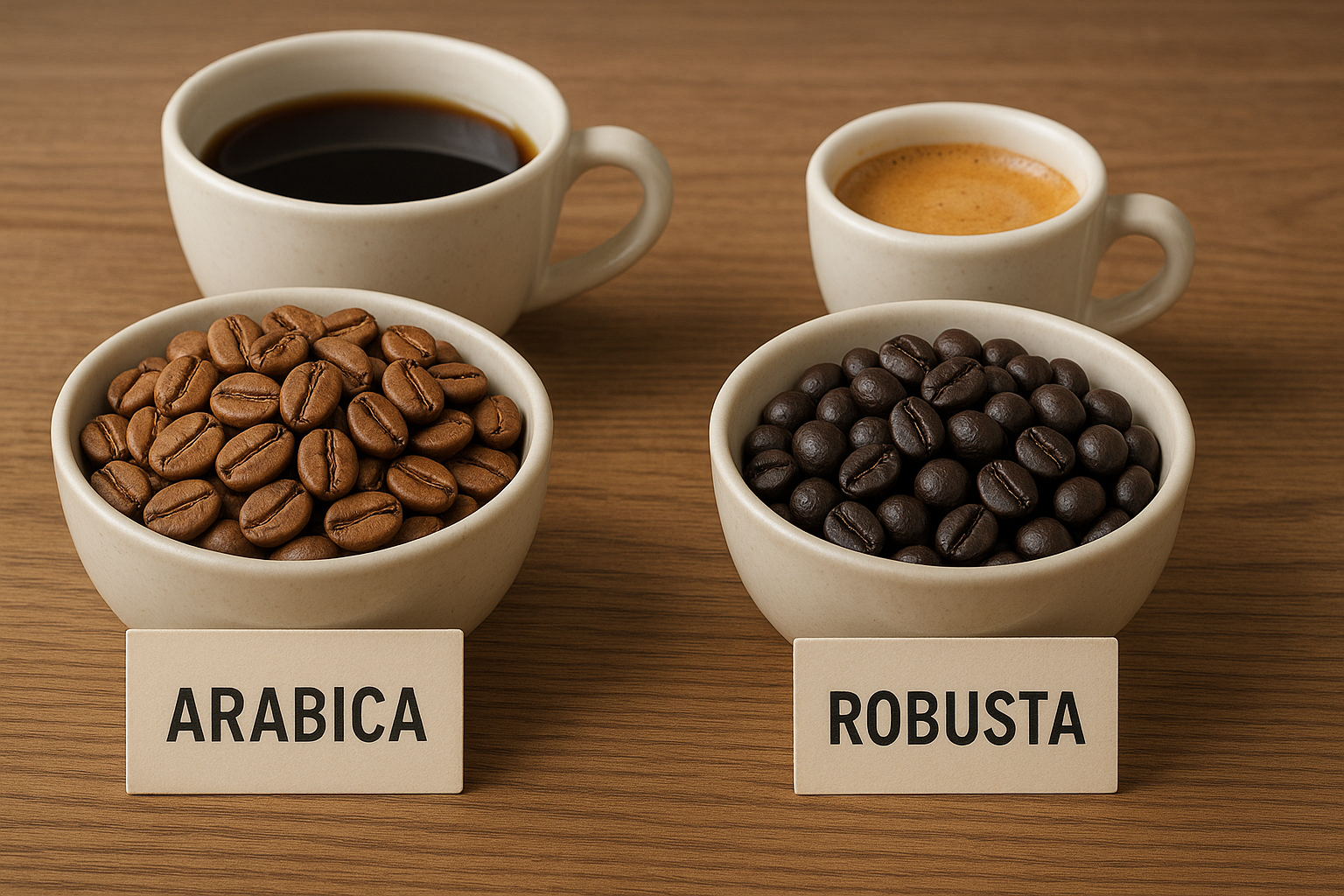When you browse coffee labels, you’ll often see the words Arabica and Robusta. These two coffee species dominate global coffee production—but they’re far from the same. From flavor and caffeine content to price and growing conditions, the differences are real—and they matter.
This guide will help you understand Arabica vs. Robusta, so you can choose the right coffee for your taste and brewing style.
1. The Basics: What Are Arabica and Robusta?
Arabica (Coffea arabica)
- Originated in Ethiopia
- Accounts for 60–70% of global coffee production
- Grows best at high altitudes (600–2000m)
Robusta (Coffea canephora)
- Native to central and western Africa
- Makes up about 30–40% of global production
- Thrives at lower altitudes (0–600m)
2. Flavor Profile: Smooth vs. Strong
| Feature | Arabica | Robusta |
|---|---|---|
| Acidity | Higher, bright and fruity | Lower, earthier |
| Sweetness | Naturally sweet, complex notes | More bitter, sometimes harsh |
| Aroma | Floral, chocolate, fruity | Woody, nutty, rubbery |
| Body | Light to medium | Full-bodied |
In short:
- Arabica = smooth, delicate, and refined
- Robusta = strong, bitter, and bold
3. Caffeine Content
| Type | Approximate Caffeine (per 100g beans) |
|---|---|
| Arabica | 1.2–1.5% |
| Robusta | 2.2–2.7% |
Robusta beans have almost twice the caffeine of Arabica.
Why It Matters:
- More caffeine = more bitterness
- Robusta’s high caffeine content also makes it naturally more resistant to pests and diseases
4. Appearance of the Beans
| Feature | Arabica | Robusta |
|---|---|---|
| Shape | Oval with curved crease | Rounder with straight crease |
| Color | Lighter green pre-roast | Darker green, denser |
| Size | Slightly larger | Smaller |
These differences may seem small, but roasters can often identify beans by look alone.
5. Growing Conditions and Cost
Arabica:
- Needs cooler, high-altitude climates
- More sensitive to pests, disease, and climate
- Requires more care, making it more expensive
Robusta:
- Grows in hotter, low-altitude regions
- Hardier and easier to cultivate
- Cheaper to produce
That’s why:
- Supermarket blends = often Robusta or Arabica/Robusta mix
- Specialty coffee = typically 100% Arabica
6. Price and Market Use
| Category | Arabica | Robusta |
|---|---|---|
| Average Price | Higher (premium) | Lower (budget-friendly) |
| Common Uses | Specialty coffee, cafés | Instant coffee, espresso blends |
7. Which One Should You Choose?
Choose Arabica if you:
- Prefer smooth, sweet, or fruity coffee
- Drink black coffee or light roasts
- Enjoy nuanced flavor and aroma
- Don’t need ultra-high caffeine
Choose Robusta if you:
- Like strong, bold, bitter coffee
- Need more caffeine (for energy)
- Enjoy espresso blends with thick crema
- Want more budget-friendly options
8. Arabica/Robusta Blends
Many brands mix Arabica and Robusta to balance cost and taste:
- Robusta adds crema and strength to espresso
- Arabica contributes flavor complexity and sweetness
Tip: If you’re new to Robusta, try a 70% Arabica / 30% Robusta blend to ease into its stronger flavor.
9. Environmental Impact and Sustainability
- Arabica is more climate-sensitive and may be harder to grow in the future.
- Robusta’s resilience could make it more viable as climate change progresses.
- However, specialty Robusta is emerging—with better farming and processing techniques.
Final Sip: It’s All About Taste and Purpose
Whether you’re choosing for flavor, budget, or caffeine, understanding the difference between Arabica and Robusta helps you make smarter choices.
✅ For delicate, rich flavor—go Arabica
✅ For bold, high-caffeine brews—try Robusta
✅ For a balance—explore blends
At the end of the day, the best coffee is the one that tastes right to you.
